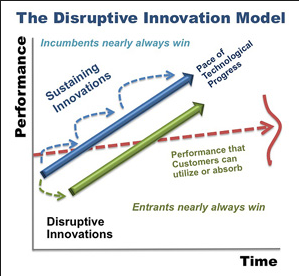So you have a great tech idea, where to start?
The convention has always been you get a new idea, you write a proposal, request funding, assemble a team, build it, perfection it and implement it then hope that it would work. Or if you’re an entrepreneur, you write your business plan, you seek funding build your idea, launch it and hope that it would work.
The problem with this approach is that no amount of surveys or data analytics can predict that your audience will actually use your new product; so you deplete a considerable amount of resources then hope that the end it didn’t all go to waste.
The cure for this problem is the new lean methodology approach. The concept is borrowed from manufacturing and applied to tech. It was made famous by Eric Ries in his book, The Lean Startup.
The ida is to seek validation before investing or building anything significant. The following article does a great job introducing the methodology.
This is related to what we discussed in class about the risk that comes with investing in big IT projects. If big organizations learn from startups and find a way to accurately test the validity of their ventures, they would reduce their risks to a more reasonable level.
Do you guys think that this method would be effective?
Is there any industries where this method wouldn’t apply?
Growth from Disruptive Innovation
Disruptive Innovation An opportunity for growth
Khattab Al-Ali outlines what businesses should do in the face of disruptive innovation and how they can use them to grow. He recommends not trying to use an innovation that your business model cannot support as well as not following competitors into new business segments if they have expertise you don’t have. He says that listening to customers for what innovations to invest in is a good idea but not to give the customers everything they want on a whim, it does not always make good business sense. He also says when evaluating disruptive innovation you need to not only focus on the standard metrics. Some innovations have consequences that people would not originally think. Finally he says that when addressing the disruptive innovation you should separate it from your main business as to not add risk to your current business.
What do you think businesses should do when evaluating new innovations? How do you think the organization should structure these endeavors?
Why Disruptive Innovation is Not a Strategy
In light of our learning about disruptive innovation and reading about companies like Apple who have used it to their advantage, I found an article claiming that disruptive innovation is not a strategy and that companies should stop striving for it. The author, Soren Kaplan, explains how while many companies are striving to create disruptive innovation strategies, the inherent vagueness of the term makes it a lousy strategy. It’s not a linear method or process, and there is no way to capture how to do it.
The idea isn’t new- originally introduced in 1942 as “creative destruction” by economist Joseph Schumpeter, and it has since become an accepted paradigm, until Jill Lapore started to chip away at the idea. She believes that the concept of disruptive innovation “has been used as an argument for blowing up the broken healthcare and education systems, which minimizes the fact that these long standing institutions are complex social services delivered by human beings, not just stale technologies ready to be displaced by the next big thing.”
The author also goes on to explain how even one of the greatest innovators of all time, Steve Jobs, didn’t try to change the industry when he started Apple. He was quoted saying “When we created the iTunes Music Store, we did that because we thought it would be great to be able to buy music electronically, not because we had plans to redefine the music industry.” Kaplan goes in to cite the founders of Google as well, claiming that they too started with a basic vision, not a grand idea of disruptive innovation and changing the world.
Do you think that disruptive innovation is a sound business strategy? Is it something to strive for or is it just something that happens?
Disaster Recovery
During class last week we talked about how all businesses with data centers in the World Trade Center went out of business within 5 years after the September 11 attacks. This got me curious about commonly forgotten/overlooked things when businesses are building disaster recovery plans. In this article from VMWare, the author describes the ten most forgotten things when businesses are building disaster recovery plans. One that I found extremely important was forgetting to test recovery plans. Companies come up with great plans for what they are going to do but they don’t take the time to test them, which doesn’t allow employees to see if their plans actually work or if their intended plans create other problems.
Have any of worked on making recovery plans at an internship or job? Which items from the article do you think are the most important? Do you think there are any items missing from the list?
Better Prototyping, Better Software

Given that we will soon be expected to demonstrate progress on our project prototypes, I searched online for software prototyping tips. I found an article at a site called Inc about how develop a strong prototype.
One excellent recommendation made in the article was to develop a prototype with your customer in mind. This point made me recall our prototype revisions in our business analysis class two semesters ago. Our initial prototype was functional, but after reviewing it, we decided that is was more closely aligned with our project team’s needs and wants than with the customer’s. Several more revisions were needed before our prototype became more intuitive and customer-oriented.
Another point made in the article is that “it’s nearly impossible to sell a product without an elegant design.” This became particularly apparent in viewing other groups’ prototype presentations; the groups’ prototypes that made the best impression on the audience were not only functional, but also looked professional and clean. As we all know from using countless applications at work and at school, it is a chore to use poorly designed software, and poor design can seriously impair an application’s functionality.
With these observations in mind, how do you plan to balance your MIS5496 prototype’s functionality with its design? What prototyping lessons did you learn from developing applications in your business analysis class and from overseeing your BA teams in MIS3596?
How Company Size Relates to IT Spending
This week we’ve come to the conclusion that company size is one of the major factors of determining how much money the company spends on IT. While I was doing research on how company size correlates to IT spending, I’ve came across interesting findings. Here is a list of key findings that I was intrigued by:
- Large companies often times spend less money on IT than small and midsized companies. The average spending of small companies is 6.9% of revenue on IT, midsize companies spend 4.1%, and large companies spend 3.2%.
- Midsized companies spend $13,100 per employee on IT, while large companies spend $11,580 per employee.
- The majority of the top performers of all company sizes utilize a more conservative approach to IT by avoiding projects that are large and by demanding quick investment payback.
What are your thoughts on these finding? Why do you think smaller companies spend more on IT than bigger companies? Do you believe these findings are accurate and why?
http://searchcio.techtarget.com/magazineContent/How-Company-Size-Relates-to-IT-Spending
Three Common Benefits of IT Chargeback
This week we’ve had discussions centered on funding, costing, pricing and chargeback. The one that particular drew my attention the most is chargeback. In the article that I stumbled upon, it explains that chargeback “is a strategy deployed where departments get an internal bill (or “cross charge”) for the costs that are directly associated to the IT Service usage” and some of the common benefits of chargeback. The three common benefits of chargeback that are mentioned in the article are:
- Business departments are held responsible for the usage they incur
- Serves as a visual reference as to the reasons why certain services cost a particular price
- Helps IT properly respond to customer demand by knowing if there needs to be an additional charge for services needed
What are some of the other benefit of utilizing a chargeback strategy? What type of business model does a chargeback strategy most suite and why?
Reinventing How IT Gets Funded

http://www.cio.com/article/2421759/business-analytics/new-model-reinvents-how-it-gets-funded.html
Instead of having a chargeback model for organizations with IT as Engine Room, do you think it is better for all organizations not in the IT is the Business or Everyone’s IT spectrum to move towards the IT as Global Service Provider that the article suggests?
The CIO Executive Board believes that the best model is the one where IT operations are broken into 12 to 24 business services and assigning costs to each one. This is very similar to how IT as Global Service Provider works as it offers a limited menu of services and avoids the tedious line item cost accounting that chargebacks require. Additionally, instead of using IT terms, the IT department would use business terms so there is no confusion on the part of the business units. The business units may not understand what it means when IT tells them they’ve used X amount of network bandwidth, but they will understand when they’re billed for videoconferencing.
Another question I have relates to IT as Global Service Provider. We’ve discussed this IT structure at length but has anyone worked at a company that’s actually modeled this way? If so, how was it?
A Lesson in Disruptive Innovation
http://www.cio.co.nz/article/565828/lesson-disruptive-innovation/
Jon Rice and Sean Walters were able to take the concept of disruptive innovation and apply it to the recruitment industry (which they said “was ripe for innovation”) by founding virtualRPO. As it’s name implies, it is a virtual platform that provides companies with their own dedicated recruitment professional, whose services they only pay for when they use.
All of their systems are cloud based and they boast that they can “deliver a better hire for half the cost.” This especially appeals to high growth companies, such as My Food Bag, because virtualRPO has contingent, flexible services that don’t force permanent and salaried recruitment functions.
Lastly, there is currently a rise in demands (that isn’t being met) for experience with cloud software, mobile, Enterprise applications and big data analytics, which is causing something of a talent war in this market segment. Tech and SaaS firms are seeking very similarly skilled individuals, so they are essentially competing against each other. This is a great opportunity for virtualRPO, as a low-cost recruiter, as technological companies need to seek third party help to find people with these skills.
Five disaster-planning steps for small businesses to implement
5 disaster-planning steps article
Today we talked about how many companies that had data centers in the World Trade Center survived 9/11. With so much talk about continuity plans in MIS 2501, it shocked me to see that zero companies were still in business a short 5 years later. When touring the data center here at Temple, just being in the atmosphere of the servers made me feel how important they are to the structure of Temple. How could a CEO in a multi-million dollar company not be worried about data being destroyed if the business revolves around it? It makes me wonder how a company could be so careless to not plan for the future so tediously.
This article by InsuranceNewsNet.com asks it’s readers, “Could your business bounce back if a disaster occurred?” They explain the 5 steps every small business should go through when planning for a disaster.
1. Consider all possible risks
2. Commercial property and casualty insurance
3. Survey your systems
4. Take your first steps now
5. Create a business continuity plan
These are all steps we have heard before, which steps do you feel are the most important?
If you could add or delete steps off this list what would they be and why?










Recent Comments